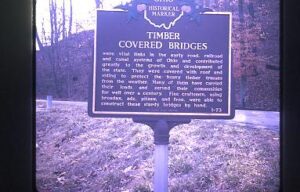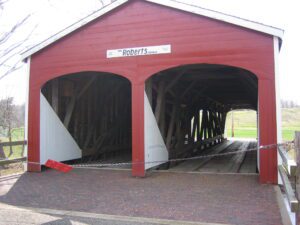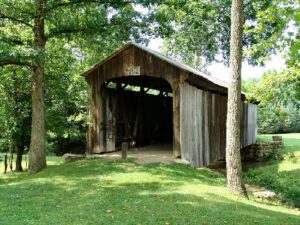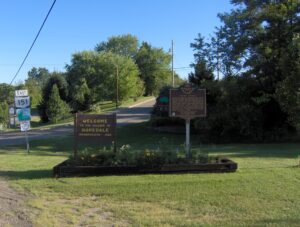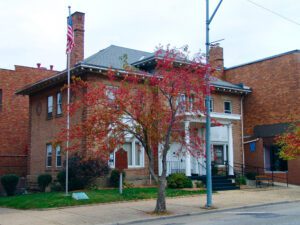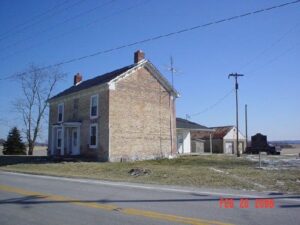, OH
This bridge, spanning Brush Creek in Brush Creek Township, Scioto County, was erected in 1874 by the Smith Bridge Company of Toledo, Ohio. Robert W. Smith was granted patents for timber trusses in 1867 and 1869, and the design for this bridge is a Smith patented truss. The supplemental arches were added in 1896. Original length of 200 feet had been shortened to its present 171 feet. This plaque has been erected to give due honor to these early timber covered bridge builders and to the men of the community who so ably assisted them. [This side of the marker contains a bridge illustration in the upper left corner]
, OH
This covered bridge in the oldest still (1962) standing in the state and the last of the “double-barreled” spans in Ohio. It was built across Seven Mile Creek on the Old Camden Road in 1829-30 by Orlistus Roberts and J.L. Campbell. Its three burr-arch trusses built of native oak and poplar with a clear span of 73 feet, support the double roadway. This plaque has been erected to give due honor to the early timber covered bridge builders of Ohio and the important spans they constructed. [This side also contains a bridge illustration in the upper left corner]
, OH
This covered bridge, spanning Salt Creek in Perry Township, Muskingum County was erected in the 1870s. It is a splendid example of an Ohio covered bridge built with Warren type trusses. It is being preserved as an important illustration of the sound, fine craftsmanship of the early bridge builders of Ohio. This plaque has been erected to give these men the honor they greatly deserve.
, OH
Platted by educator and abolitionist Cyrus McNeely in 1849, Hopedale was the site of McNeely Normal School, later Hopedale Normal College, the first coeducational college for teachers in eastern Ohio. It operated from 1849 to 1902. Among its graduates was George Armstrong Custer in 1856. Hopedale served as an important stop on the Underground Railroad for slaves fleeing bondage in the southern states. Local tradition notes several “stations” in the village, three at private homes and one at a hotel.
, OH
The first Scottish Rite body of Free Masonry west of the Alleghenies was formed in Cambridge, Ohio, in 1852 by Killian H. Van Rensselaer, an honorary 33rd Degree Mason. He lived in this city from 1851 to 1867. Van Rensselaer was superintendent of construction of the present railroad tunnel west of Cambridge. He died in Cincinnati in 1881 at the age of 80.
, OH
The inn was built 1800-01 by Peter Wickerham, a Revolutionary War veteran. It was used as an overnight stagecoach stop and tavern on Zane’s Trace until ca. 1850. Runaway slaves were hidden here when the “Underground Railroad” was in operation. Confederate soldiers, commanded by General John Hunt Morgan, slept in the inn on the night of July 15, 1863, when “Morgan’s Raiders” passed through Adams County.
, OH
Sciotoville Bridge, 1917, designed and built by two famous American Civil Engineers, Gustav Lindenthal, D.Sc. (1850-1935), the Consulting Engineer (and) David Barnard Steinman, D.Sc. (1887-1960), the designer and stress analyst. A double track railroad bridge of twin spans each 775 feet long, it remained until 1935 the longest continuous truss bridge in the world and stands today as the prototype for continuous structures. Its construction marked a major advance in the art of bridge engineering and was a pioneer achievement in continuous truss analysis. In beauty of design, size and erection techniques it stands as a landmark of progress in man’s mastery of his environment.
, OH
One of Ohio’s most influential politicians in the early 20th century, Washington Court House native Harry Daugherty (1860-1941) was widely known as a “President-maker” and served instrumental roles in President Warren G. Harding’s administration, culminating a long career in state and national politics. As Attorney General from 1921 to 1924, Daugherty established the first federal women’s penitentiary, recommended former president William Howard Taft to the Supreme Court, and ended a controversial 1922 railroad strike. Implicated in scandals complicated by the suicide of his assistant and fellow Fayette County native Jess Smith, Daugherty was eventually cleared in congressional investigations and two bribery trials, and subsequently published an insider’s account of the Harding Administration. Both Daugherty and Smith are buried in Washington Cemetery.


